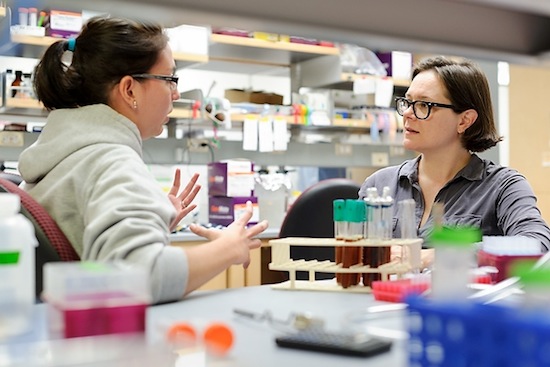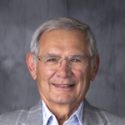Studies point to rising role for women scientists at UW-Madison

Audrey Gasch, right, associate professor of genetics, and Maria Sardi look at yeast cultures in the Genetics-Biotechnology Center Building.
Photo: Jeff Miller
As the University of Wisconsin–Madison competes with the world’s top universities for talent and expertise, it is getting more help from women, who in 2011 comprised 31 percent of the faculty — up from 18 percent in 1990.
The goal in ensuring that hiring is based on ability and achievement is not to achieve an “arbitrary ratio,” says Donna Paulnock, associate dean for biological sciences in the Graduate School. “The goal is having as many women as possible in any pool of applicants so we can evaluate them according to their accomplishments, and hire the best person.”
Between 2000 and 2011, women faculty grew from 19 percent to 28 percent in the biological sciences, and from 9 percent to 16 percent in the physical sciences.
A series of wide-ranging discussions found satisfaction with the progress toward gender equality on campus, and a feeling that several UW–Madison initiatives are helping ensure equality, diversity and excellence. At the same time, there’s a strong sense that more work remains before women are fully represented in the faculty.
One limiting factor is the “leaky pipeline,” the loss of women on the path from Ph.D. to tenured professor. According to Jennifer Sheridan, executive director of the Women in Science and Engineering Leadership Institute (WISELI), “Women are getting around 50 percent of the Ph.D.’s in the biological sciences, but we are hiring women assistant professors at about the 30 percent level. During the long post-doctoral phase, people have to move around so much. Women are more likely to have partners who are academics, and they often have young children; both factors make it harder to move.”
Workload also plays a role. In WISELI’s 2010 survey of work life, women faculty across the university reported working 56 hours per week, and 58 hours for men.
That workload can be intimidating, says Wendy Crone, associate dean for graduate education in the Graduate School. “Students look at the faculty and say, ‘I can’t quite imagine fitting a family into those untenured years.'”
The leaky pipeline “highlights the need for supporting young parents — female and male,” says Paulnock. “We’ve discussed adding child care resources, better parental leave policies, and a better way to share job positions during the early career, but these are not all fully developed.”
Spousal hires are another difficulty that affect both men and women, and while the university does use its network to find opportunities for spouses, success is not guaranteed.
Considering these roadblocks toward attaining a faculty that fully represents Wisconsin and offers the maximum benefit to the state, the university, and its students, what accounts for the fairly steady progress?
A changing social climate has helped, Paulnock says. “Many of the men I have observed on the academic career track are completely at ease with the idea of gender balance.”
Numerous summer outreach programs help increase the overall representation of women in science and technology fields. The new “Grand Challenges for Engineering” initiative, directed by Amy Wendt, professor of electrical and computer engineering, is developing an outreach program with six Wisconsin middle schools that presents engineering as a problem-solving discipline. “Middle school is the time when students start making choices about what they’ll take in high school,” Wendt says. “We will expose them to the humanitarian applications of engineering before they’ve ruled out engineering without really knowing what it is.”
Recruiting has been a focus at WISELI, says Sheridan. “We have a workshop series for faculty and others on search committees that goes, step-by-step, through the hiring process. If one goal of recruitment is diversity, you have to find new places to search. Phone calls, attending professional society meetings, talking to new people are all important parts of the process.”
“UW-Madison has pioneered the discussion of unconscious biases and assumptions,” says Sheridan. “We discuss studies from social psychology, such as experiments that show how unconscious bias might disadvantage women or minorities. These are not intentional biases, and the way to guard against them is to know how they work.”
Once hired on the tenure track, assistant professors face multiple challenges — getting grants, teaching, and preparing for tenure. At UW–Madison, all young tenure-track faculty get a departmental mentor, and can choose from other options to get advice and support while approaching the tenure decision.
Audrey Gasch, an associate professor of genetics who received tenure in 2011, says, “In grad school I was convinced that I would not be in academia because I thought it was too stressful; it would be hard to balance with a family life. But I feel very supported by my department and colleagues on campus. If the kids are sick or there’s a child care issue, having colleagues who are understanding has been the best type of support.”
Parents and others with family issues can add time to the seven-year “tenure clock” that starts when an assistant professor is hired. “I feel we’ve gotten over concerns about requesting extra time on the tenure clock, due to parental or family leave, or other life situations,” says Paulnock. “This request is no longer seen as a sign of weakness.”
In both physical and biological sciences, the tenure approval rate for women exceeds that for men.
The long quest for parity, and the desire to move women into positions of authority at UW–Madison, has gotten a major boost from WISELI, and co-director Molly Carnes, a professor of geriatrics and adult development, says, “After consulting at med schools around the country, I’m so happy to come back here. At some of those schools, people still talk about gender and diversity in hushed tones. Here the dialog is overt, we recognize that diversity is good for the institution and our students.”
The drive for improvements must come from the top, says Robert Golden, dean of the School of Medicine and Public Health. “When the dean’s office recruits a department chair, we take the extra steps, and that produces a clear message that the school is serious about diversity. If it’s just talk, people will think you are just doing what you have been told to do.
“By having more strong women in leadership positions, we will encourage more women to go into academic medicine, and that will encourage more girls in junior high and high school to seek careers in medicine,” Golden says. “Sometimes a patient feels most comfortable seeing a doctor whom they can more readily identify with, because they are the same gender or have the same cultural background. So ultimately we serve the health of the people of Wisconsin by having a physician work force that represents them.”
Overall, says Crone, the picture is mixed for women at UW–Madison. “We’ve seen progress, but it’s slow, and there are plateaus. There is no magic bullet. This must be tackled from a whole range of perspectives.”


